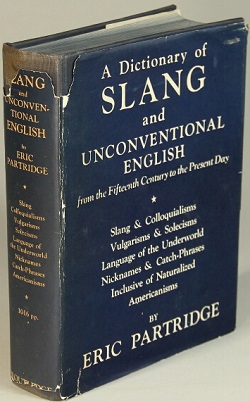
Rhyming slang is a form of slang word construction in the English language. It is especially prevalent among Cockneys in England, and was first used in the early 19th century in the East End of London; hence its alternative name, Cockney rhyming slang. In the US, especially the criminal underworld of the West Coast between 1880 and 1920, rhyming slang has sometimes been known as Australian slang.
A slang is a vocabulary of an informal register, common in everyday conversation but avoided in formal writing. It also often refers to the language exclusively used by the members of particular in-groups in order to establish group identity, exclude outsiders, or both. The word itself came about in the 18th century and has been defined in multiple ways since its conception, with no single technical usage in linguistics.
Colloquialism is the linguistic style used for casual (informal) communication. It is the most common functional style of speech, the idiom normally employed in conversation and other informal contexts. Colloquialism is characterized by wide usage of interjections and other expressive devices; it makes use of non-specialist terminology, and has a rapidly changing lexicon. It can also be distinguished by its usage of formulations with incomplete logical and syntactic ordering.

Tok Pisin, often referred to by English speakers as New Guinea Pidgin or simply Pidgin, is a creole language spoken throughout Papua New Guinea. It is an official language of Papua New Guinea and the most widely used language in the country. However, in parts of the southern provinces of Western, Gulf, Central, Oro, and Milne Bay, the use of Tok Pisin has a shorter history and is less universal, especially among older people.
Anna Wierzbicka is a Polish linguist who is Emeritus Professor at the Australian National University, Canberra. Brought up in Poland, she graduated from Warsaw University and emigrated to Australia in 1972, where she has lived since. With over twenty published books, many of which have been translated into other languages, she is a prolific writer.
Natural semantic metalanguage (NSM) is a linguistic theory that reduces lexicons down to a set of semantic primitives. It is based on the conception of Polish professor Andrzej Bogusławski. The theory was formally developed by Anna Wierzbicka at Warsaw University and later at the Australian National University in the early 1970s, and Cliff Goddard at Australia's Griffith University.
Ethnolinguistics is an area of anthropological linguistics that studies the relationship between a language or group of languages and the cultural behavior of the people who speak those languages.

Eric Honeywood Partridge was a New Zealand–British lexicographer of the English language, particularly of its slang. His writing career was interrupted only by his service in the Army Education Corps and the RAF correspondence department during World War II.
Bollocks is a word of Middle English origin meaning "testicles". The word is often used in British English and Irish English in a multitude of negative ways; it most commonly appears as a noun meaning "rubbish" or "nonsense", an expletive following a minor accident or misfortune, or an adjective to describe something that is of poor quality or useless. It is also used in common phrases like "bollocks to this", which is said when quitting a task or job that is too difficult or negative, and "that's a load of old bollocks", which generally indicates contempt for a certain subject or opinion. Conversely, the word also appears in positive phrases such as "the dog's bollocks" or more simply "the bollocks", which will refer to something which is admired or well-respected.
Bugger or buggar can at times be considered as a mild swear word. In the United Kingdom the term has been used commonly to imply dissatisfaction, refer to someone or something whose behaviour is in some way inconvenient or perhaps as an expression of surprise. In the United States, particularly in the Midwest and South, it is an inoffensive slang term meaning "small animal".
A sticky wicket is a metaphor used to describe a difficult circumstance. It originated as a term for difficult circumstances in the sport of cricket, caused by a damp and soft wicket.
Sexual slang is a set of linguistic terms and phrases used to refer to sexual organs, processes, and activities; they are generally considered colloquial rather than formal or medical, and some may be seen as impolite or improper.

A hair's breadth, or the width of human hair, is used as an informal unit of a very short length. It connotes "a very small margin" or the narrowest degree in many contexts.
Cliff Goddard is a professor of linguistics at Griffith University, Queensland, Australia. He is, with Anna Wierzbicka, a leading proponent of the Natural Semantic Metalanguage approach to linguistic analysis. Goddard's research has explored cognitive and cultural aspects of everyday language and language use. He is considered a leading scholar in the fields of semantics and cross-cultural pragmatics. His work spans English, indigenous Australian languages, and South East Asian languages. He was elected a Fellow of the Australian Academy of the Humanities in 2003.

"Shut up" is a direct command with a meaning very similar to "be quiet", but which is commonly perceived as a more forceful command to stop making noise or otherwise communicating, such as talking. The phrase is probably a shortened form of "shut up your mouth" or "shut your mouth up". Its use is generally considered rude and impolite, and may also be considered a form of profanity by some.

A Dictionary of Slang and Unconventional English is a dictionary of slang originally compiled by the noted lexicographer of the English language Eric Partridge. The first edition was published in 1937 and seven editions were eventually published by Partridge. An eighth edition was published in 1984, after Partridge's death, by editor Paul Beale; in 1990 Beale published an abridged version, Partridge's Concise Dictionary of Slang and Unconventional English.

She'll be right is a frequently used idiom in Australian and New Zealand culture that expresses the belief that "whatever is wrong will right itself with time", which is considered to be either an optimistic or apathetic outlook.
No problem is an English expression, used as a response to thanks. It is regarded by some as a less formal alternative to you're welcome, which shares the same function.

Yiff is a slang term used in the furry fandom to refer to pornographic content of anthropomorphic animal characters. It is considered a tongue-in-cheek term in the furry fandom. The term is also used as a way to insult members of the furry fandom, such as in the phrase "yiff in hell". Additionally, the term is also used in the plushie fetish community.








